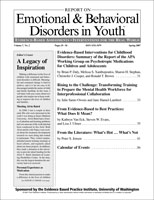Complete Issue
Author: Stacey M. Cornett.
Source: Volume 16, Number 03, Summer 2016 , pp.53-80(28)

< previous article |return to table of contents
Abstract:
This issue of EBDY offers readers new and important insights into the complexities of supporting youth with emotional and behavioral disorders. In an effort to best address the child in need, most child-serving professionals are highly focused on how to address unmet physical, emotional, spiritual, and environmental needs while supporting ideal caregiving experiences. Although all of these tasks may not be the responsibility of one provider, it is necessary to refer and support these needs through a network of support. Often, providers in home-based services,school settings, and other youthserving entities come together in care coordination meetings in which monitoring and oversight can occur. These tasks are now seen as essential in supportinga child’s maximum functioning. Two of the articles in this issue highlight methods for ensuring that caregivers’ needs in supporting their children are at the forefront of what child-serving professionals do. Rabinovitz and colleagues share a thorough review of home visiting programs highlighting issues related to retaining participants in services. Bessman and Wallace describe and support the clear need for caregivers to learn strategies to best navigate the child-serving system and fully partner with professionals in designing the needed services for their children. Serving children from a family perspective and listening carefully to the unmet needs a family has are central tenets of home-based services and family support movements. It is an additional challenge to understand how a child may be affected by educational challenges, developmental needs, and co-occurring conditions. Sanger and colleagues contribute to understanding this topic by depicting the needs of children with co-occurring speech and language challenges and behavioral health disorders. Understanding the way in which these two conditions intersect can lead to significant changes in the way a child is supported. This concept is true for families as well as professionals. Although the field is rapidly advancing in terms of techniques and practices, there remains a critical focus on what is needed to fully support caregivers in meeting their children’s needs. Often the best way for this to be fostered and modeled is through the use of parent support partners. Regardless of strategy, this issue gives many ideas about how to support the whole child while fully engaging and partnering with caregivers. Whether this happens through home-based services, advocacy, peer support and mentoring, or education regarding a child’s condition, this is a strongly recommended practice that is shown to produce change. In addition to the articles cited above, the complete issue includes a Calendar of Events for July 2016—September 2016.Keywords: Ensuring Caregivers’ Needs Are Met; Understanding the Effects of Co-Occurring Conditions
Affiliations:
1: Children’s Home of Cincinnati.